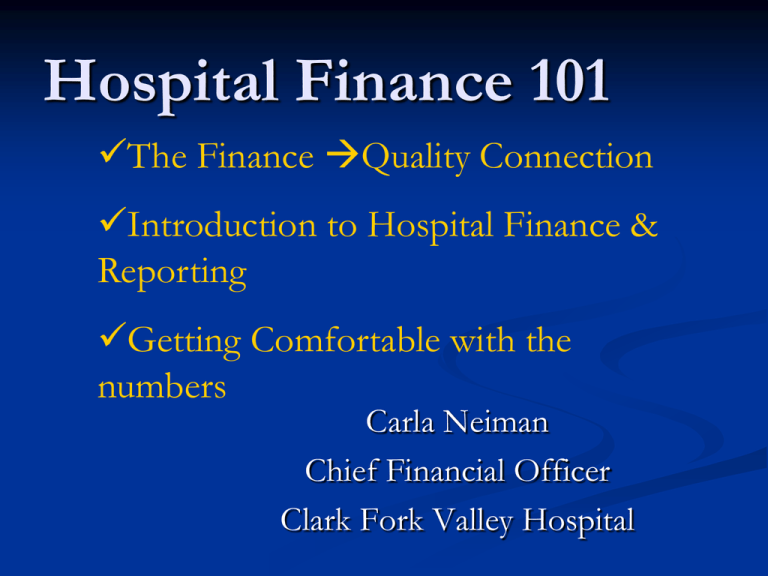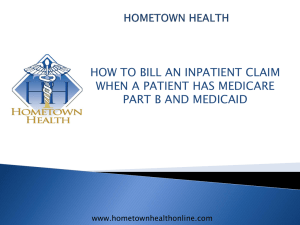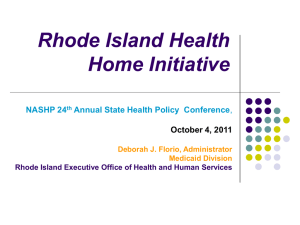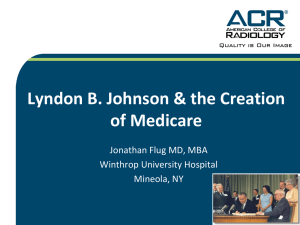Orientation to Clark Fork Valley Hospital Finance for Board Members
advertisement

Hospital Finance 101 The Finance Quality Connection Introduction to Hospital Finance & Reporting Getting Comfortable with the numbers Carla Neiman Chief Financial Officer Clark Fork Valley Hospital What is your F Quotient? Discussion Topics Why Finance? Basic Hospital Finance & Reporting How the goals of financial performance and quality care are related & integrated How to understand and use your hospital’s financial information Current Trends in Healthcare Finance & Reimbursement Affordable Care Act and coming payment reforms Why Finance? Margin vs. Mission One of the most important characteristics of ANY business is its financial performance & condition Financial Analysis evaluates a business’s financial performance & condition Does it have the financial capacity to fulfill its mission? By assessing the financial health of our hospital we can identify strengths & weaknesses The principal of Stewardship The Quality Connection The financial impact of quality on your hospital Cost of new technology and the evolving “standard of care” Adverse events Lawsuits, insurance claims and insurance cost Community image – consumer assessment Payer impact – Never Events, credentialing & payment reform Survey agencies Publicly reported quality data The evolving relationship between quality and cost in health care The “Cost of Quality” - 1990 “…costs and quality of care cannot be separated from each other. Higher quality often requires increased expenditures. When this occurs, decision makers must reconcile the desire for higher quality with the desire for cost control.” –Kovener & Neuhauser, 1990 The evolving relationship between quality and cost in health care The “Cost of Poor Quality” - 2005 Process improvement & resulting reduction in cost, LEAN, Six Sigma “Although health care differs in many ways from manufacturing, there are also surprising similarities: Whether building a car or providing health care for a patient, workers must rely on multiple, complex processes to accomplish their tasks and provide value to the customer or patient. Waste – of money, time, supplies or good will – decreases value…” --Institute for Healthcare Improvement (2005) The Quality Connection High Cost does not mean High Quality “Despite having the most costly health system in the world, the United States consistently underperforms on most dimensions of performance compared with other industrialized countries…” –Karen Davis, President, Commonwealth Fund Introduction to Hospital Finance & Reporting How the hospital gets and spends its money Financial Statements Audited vs. Interim Statement of Operations (Income Statement) Statement of Financial Position (Balance Sheet) Statement of Cash Flows Other Financial Reports Statistical Reports Accounts Receivable Status Labor Productivity Report Statistical Reporting Hospital revenues tend to be volume driven and revenues are well demonstrated with statistics Statistical reports should compare actual statistics to budget for current period and yearto-date One should see a reasonable correlation between variances in statistics and corresponding categories of revenue Typical Statistics to Review Average Daily Census (by unit, by category) Patient days Outpatient Visits Surgery minutes Case mix index Emergency Room visits Clinic visits Revenue per day and per visit Statistical Report example Description Actual Budget Variance Avg YTD Hospital ADC 4.2 4.7 (.5) 3.9 Surgery Minutes 3709 2778 931 2636 Outpatient Visits 1370 1483 (113) 1388 Dashboard Report Clark Fork Valley Hospital Dashboard Report L eg end rte r Y TD Q ua 0 2 01 10 - 20 -1 0 Se p -1 0 A ug 10 J ul- -1 0 J un 0 -10 0 -1 Ma y A pr -1 Ma r 10 -10 Fe b J an ar k ch M0 10 2 Be n 3 rd ar k ch M0 09 2 Be n 9 2 00 -09 -0 9 N ov D ec Y TD INDICATOR Volume Indicators Acute Care ALOS/Hrs Acute care ADC # ER visits # Observation hours Swing Bed ADC # Total OP Visits Surgery Minutes Family Medicine Network - Visits 70 93 71 70 < 96 58 64 73 78 61 57 65 65 65 < 96 CAH 4.6 4.8 5.0 4.6 4.5 1.5 3.2 5.9 4.7 4.2 2.0 2.8 2.8 3.5 4.7 CFVB 221 197 180 215 221 184 201 259 186 203 190 260 260 212 218 CFVB 206 113 59 137 188 33 120 54 175 133 167 143 143 118 154 CFVB 1.6 2.9 2.9 1.8 2.6 3.5 3.2 3.6 0.7 1.3 1.6 1.0 1.0 2.1 2.0 CFVB 1398 1251 1323 1416 1500 1464 1269 1387 1452 1370 1507 1352 1352 1400 1483 CFVB 1866 3164 3172 2510 2785 2239 2059 2720 2455 3709 1424 2639 2639 2464 2778 CFVB 1542 1323 1397 1483 1711 1322 1303 1828 1616 1438 1606 1354 1354 1495 1931 CFVB 25.9 27.2 28.4 20 - 25 24.0 18.2 30.2 29.11 33.3 42.6 39.7 Financial Indicators Days Cash On Hand EBITDA % S & B /NR Days in AP Days in AR 25 - 28 CFVS 153434 73 59 70 25.4 23.4 63 63 64 160404 CFVB <57 73 78 57 60 56 67 57 64 <59 CFVS 31.5 <35.0 30.0 33.7 45.2 41.0 27.3 27.5 22.5 <35.0 CFVS 59 <60 57 61 62 56 57 53 55 <60 CFVS The Statement of Operations Also called the “Income Statement” – this report outlines actual revenues and expenses, as compared to budget, and is the most important gauge of the positive or negative results of the hospital’s operations for the period. Hospital Revenues Operating Revenue Directly related to operations Volume driven Other Operating Revenue Indirectly related to operations Non-Operating Revenue Not related to operations COMMUNITY GENERAL HOSPITAL STATEMENT OF OPERATIONS FYE 12/31/2008 Audited Gross Patient Service Revenues Inpatient Revenue $ 45,685,914 Outpatient Revenue $ 52,267,576 Physician Revenue $ 3,888,000 Total Patient Service $ 101,841,490 Revenue FYE 12/31/2009 Audited CY As of 6/30/2010 Interim $ 51,168,224 $ 60,107,712 $ 5,841,777 $ 117,117,714 $ 28,921,427 $ 34,762,285 $ 3,342,846 $ 67,026,557 Revenue Deductions Contractual Allowances $ (19,161,125) Charity Care $ (10,235,845) Total Deductions $from (29,396,970) Revenue $ (21,077,238) $ (12,283,014) $ (33,360,252) $ (12,646,343) $ (6,755,658) $ (19,402,000) Net Patient Service $ Revenue 72,444,520 $ 83,757,462 $ 47,624,557 Other Operating Revenue $ 1,770,569 $ $ Net Operating Revenue $ 74,215,089 $ 85,687,382 1,929,920 964,960 $ 48,589,517 Operating Revenues Routine – Inpatient Room & Bed Charges Ancillary – Inpatient & Outpatient Lab, Imaging, Pharmacy, Therapy, Supplies, ER, Surgery, Home Health Clinic Deductions from Revenue “No one pays full price…” Contractual Discounts/Allowances Charity Care Policy Discounts – Employee discounts, Administrative Discounts Monthly Allowance Estimates Net Patient Service Revenue This is the difference between Gross Charges and Contractual Allowances This is the NET amount of revenue we expect to collect after discounts to patients and public/private payers Hospital Service Revenue & Margin Lab Test A Charge/Price = $25.00 Payment (varies w/payer) Medicare = $18.00 Cost = $13.00 Charge – Payment = Contractual Adjustment Payment – Cost = Contribution Margin Payer Types & Payment Methodology – Hospital Medicare and Medicaid Hospital CAH Cost Based Non-CAH Prospective Payment (DRG & APC) Commercial Insurance – Fee for service and discounts from charges, DRG or case payments, capitation Private Pay – Prompt pay discounts, charity care, bad debt expense Medicare Swingbed – Per Diem based on Cost per Day Payer Methodology Other Services Medicare DME, Lab, Mammo – Fee Schedule Medicare Home Health – Episode Based Medicaid Nursing Home – Per Diem based on Facility Rate set by the state Medicare Nursing Home – Prospective payment based on RUG coding Medicare Rural Health Clinic – Payment per visit @ cost Physician – RBRVS based on rate per RVU Evolution of Payment Methodology Incentives! DRG’s 1983 APC’s 2000 Home Health Episodes 2000 Future… Value-based Purchasing; Accountable Care Organizations; Payment for outcomes vs. fee for service Hospital Service Mix Clinics 15% OP Hospital 46% Inpatient 27% Long Term Care 8% Swingbed 4% Outpatient Service Mix Thompson Falls Clinic Bull River Clinic 8% 1% Hot Springs Clinic 6% Emergency Room 21% Plains Clinic 9% Observation 4% OP Surgery 9% Outpatient 33% Recurring Outpatient 8% Home Oxygen 1% Revenue Payer Mix Workers Comp 2% Tribal Health 1% Self Pay 11% Comm'l 11% BCBS 10% Champus Medicaid 2% 15% Medicare 48% Other Operating Revenue Cafeteria Revenue Medical Records Revenue Rental Revenue Outreach Revenue Non-Operating Revenue Interest Gains and Losses on Fixed Assets and Joint Ventures Grants & Charitable Donations Operating Expenses Staffing – Salaries, Benefits, Professional Fees Supplies & Other – Medical and Non-Medical Supplies, Purchased Services, Insurance, Utilities, Repair & Maintenance, Lease & Rental Depreciation Interest Bad Debt Other Expense – Postage, Travel, Dues & Subs, Taxes Net Operating Revenue $ 74,215,089 Operating Expenses Salaries $ 37,339,563 Benefits $ 6,195,810 Professional Fees $ 2,540,480 Supplies $ 1,205,458 Purchased Services $ 2,725,896 Utilities $ 2,921,005 Insurance $ 895,600 Interest $ 423,721 Depreciation & Amortization $ 4,693,531 Provision for Bad Debt $ 6,453,850 Other Expenses $ 3,586,952 Total Operating Expenses$ 68,981,866 Operating Gain (Loss) $ 5,233,223 Non-Operating Gains (Losses) Gain (Loss) on Disposal$ (452,360) Unrestricted Contributions $ 348,000 Total Non-Operating Gain$(Loss) (104,360) Net Income (Loss) $ 5,128,863 Operating Expenses Interest 4% Bad Debt Other Expense 6% 1% Depreciation 6% Supplies & Other 23% Staffing 60% The Balance Sheet The Statement of Financial Position or Balance Sheet is a snapshot of the financial position of the organization at a specific point in time. It can tell us a lot about the financial health of the business. Assets Short Term Cash and Investments Accounts Receivable – gross vs. net Other Receivables – Third Party Payers, Non-patient receivables Inventory Prepaid Expenses Long Term Property Plant & Equipment – at cost less accumulated depreciation Other Assets – Restricted assets, Joint Ventures, Intangibles, such as good will Liabilities Short Term Accounts Payable Accrued Compensation Other Accrued Expenses Line of Credit Current Portion of Long Term Debt Long Term Mortgage & other Long Term Debt Payable Capital Leases Net Assets or Fund Balance This is the equivalent of “equity” in a non-profit Unrestricted Fund Balance Restricted Fund Balance Current Year’s Operations Balance, if interim CASH – What really keeps the hospital ticking! The importance of monitoring cash flows While Revenues and Expenses offer an excellent assessment of the financial outcome of operations, the bottom line is not directly indicative of real-time financial performance, since most revenues are not collected at the time of service, most expenses are not paid when incurred and non-cash expenses, while important, do not have a direct impact on our financial resources The Revenue Cycle Sources of Cash Collection of Accounts Receivable Cash Services Investment Income Sale of Assets Financings Unrestricted Donations Capital Contributions Applications of Cash Payments to Employees of Accrued Compensation Payments to Suppliers of Accounts Payable Payments to Lenders for Principal and Interest Purchase of Fixed Assets Investments Statement of Changes in Cash Net Income (Loss) Results of Operations Add back Non-Cash Expenses (Depreciation, Amortization) Identifies sources & uses of cash during the accounting period to explain the change in the cash balance COMMUNITY GENERAL HOSPITAL STATEMENT OF CASH FLOWS FYE 12/31/2009 Cash Flows from Operating Activities Operating Income Adjustments to Reconcile Operating Income Depreciation & Amortization Interest Expense Decrease (increase) in Current Assets Accounts Receivable (net) Other Receivables Inventories Prepaid Expenses Increase (decrease) in Current Liabilities Accounts Payable Accrued Compensation Other Current Liabilities Net cash provided by operating activities $ 7,946,517 $ 5,022,078 $ 453,381 $ $ $ $ (856,000) (150,000) (124,000) (35,000) $ 1,191,000 $ 500,000 $ $ 13,947,977 Cash Flows From Noncapital Financing Activities Cash received from donations & other non-operating revenues $ Cash Flows from Capital and Related Financing Activities Principal Payments on long-term debt Interest Paid Proceeds from new debt Payments for purchase of property, buildings & equipment Proceeds from sale of equipment Net cash used in capital and related financing activities $ (1,456,360) $ (453,381) $ 750,000 $ (7,080,613) $ 50,000 $ (8,190,354) Cash Flows from Investing Activities Investment in Joint Ventures Other Investments Net Cash Used in Investing Activities $ 50,000 $ (5,685,622) $ (5,635,622) Cash and Cash Equivalents, beginning of year Cash and Cash Equivalents, end of year $ 1,489,000 $ 2,015,000 404,000 Accounts Receivable Analysis Increased Accounts Receivable is a drain on cash flow Optimizing the “Revenue Cycle” means capturing charges, generating bills and collecting from payers as quickly as possible, so that the resulting cash can be used to fund operations Accounts cannot be collected until they are billed Accounts Receivable Analysis Report Breakdown by Patient Type (Inpatient, Outpatient, SNF) with prior month comp Breakdown by Payer Type (Medicare, Medicaid, Commercial, Self Pay) with prior month comparison Aging of Accounts Receivable Unbilled Accounts Receivable Gross Days A/R Outstanding w/ prior month comparison Revenue and Revenue Day Equivalent Days Revenue in Accounts Receivable Outstanding Total Accounts Receivable / Average Revenue per day This is a measure of how many days it takes to collect patient accounts, on average This will vary by payer and type of service Medicare will pay a clean bill in 14 days Private Pay nursing home accounts are generally paid in advance Self pay bills may take several months to a year (or more) to be paid off ACCOUNT CLARK FORK V ALLEY AND CLI NI CS INPATIENT 1. 2. 3. 4. 5. 6. 7. OUTPATIENT 8. 9. 10. 11. 12. 13. 14. 15. CLINICS 16. 17. 18. 19. 20. 21. Month Ending: Medicare Medicare SwingBeds Medicaid Comm Insur/Other Private/Self Pay Unbilled Total Inpatient 0-30 53,238 0 0 14,628 (2,945) 86,699 $151,621 Medicare Medicaid Comm Insur/Other Private/Self-Pay Unbilled Total Outpatient 233,337 11,728 129,640 49,820 329,952 $754,478 Total Hosp. Accts. Rec. Number of Days Medicare Medicaid Comm Insur/Other Private/Self-Pay Unbilled Total Outpatient NURSING HOME 22. 23. 24. 25. 26. Medicare Medicaid Private Unbilled Total Nursing Home A/R 27. Total Accounts Receivable 22. Accounts in Pre Collect 31-60 1,385 0 466 41,246 22,216 61-90 0 0 882 11,715 33,193 AGI NG JUNE 2010 91-120 6,263 0 (15,002) 8,595 9,624 121-150 1,596 0 454 0 2,697 151+ 5,901 6,167 (1,818) 14,562 206,877 $65,313 $45,790 $9,479 $4,747 $231,689 32,671 10,969 58,400 107,356 31,301 5,117 17,384 79,191 10,299 4,806 10,815 89,850 12,885 54 22,634 87,351 99,500 3,518 7,789 321,329 $209,396 $132,993 $115,770 $122,924 $906,099 23 $274,709 7 $178,782 5 $125,249 3 $127,671 3 71,395 7,448 47,057 5,658 35,042 $166,600 3,289 1,294 18,141 32,718 2,279 233 4,803 25,780 $55,441 $33,094 $26,994 0 0 680 0 0 8,672 0 4,486 3,856 0 (4,441) (6,882) 0 7,449 21,121 $680 $8,672 $8,343 ($11,324) $28,569 $275,389 $187,454 $133,592 0 10,425 (48,384) 124,421 $86,462 $992,560 R E V E N U E INPATIENT 1. 2. 3. 4. 5. 6. OUTPATIENT 7. 8. 9. 10. 11. CLINICS 12. 13. 14. 15. 16. NURSING HOME 17. 18. 19. 20. RECEI V ABLE HOS P I TAL 250 (49) 4,066 22,727 No. of Days Total 3 Months Revenue 559,213 74,548 107,423 284,299 38,199 $1,063,682 515 74 1,828 19,133 $21,550 $116,348 Medicare Medicare SwingBeds Medicaid Comm Insur/Other Private/Self Pay Total Inpatient May Revenue 178,765 30,725 30,580 133,876 36,158 $410,105 Apr Revenue 204,994 12,025 67,364 122,742 14,825 $421,950 Medicare Medicaid Comm Insur/Other Private/Self-Pay Total Outpatient 434,990 57,642 224,174 107,344 $824,150 553,686 66,527 225,390 69,063 $914,666 426,274 67,866 189,120 77,435 $760,695 1,414,950 192,035 638,684 253,841 $2,499,511 $15,380 $2,087 $6,942 $2,759 $27,169 Medicare Medicaid Comm Insur/Other Private/Self-Pay Total Clinics 116,690 26,535 94,406 36,970 $274,601 128,316 22,842 77,441 31,558 $260,157 124,284 23,301 85,803 25,513 $258,900 369,290 72,678 257,650 94,040 $793,657 $4,014 $790 $2,801 $1,022 $8,627 Medicare Medicaid Private Total Nursing Home 0 121,687 5,298 $126,984 0 131,279 10,596 $141,875 0 117,647 14,137 $131,784 0 370,613 30,030 $400,643 $0 $4,028 $326 $4,355 Prior Month 145,591 102,345 16,209 141,134 310,599 143,236 $859,113 Cur Days 11 8 (13) 29 654 44 521,758 32,791 246,999 698,706 344,148 $1,844,401 27 17 36 266 $432,136 419,994 36,191 246,662 734,897 329,952 $1,767,697 $663,825 17 $2,276,335 59 $2,703,514 63 59 78,722 8,094 80,601 161,176 35,042 $363,635 77,455 10,604 88,656 153,362 34,508 $364,585 5 4 12 58 0 17,918 (20,938) 124,421 $121,401 0 12,295 (15,050) 139,284 $136,529 994 (905) 4,707 55,161 $59,956 $692,394 92 Total AR O/S Average Total AR Unbilled Daily Revenue $6,078 $810 $1,168 $3,090 $415 $11,562 June Revenue 175,454 31,797 9,478 27,681 (12,784) $231,628 Current Month 68,383 6,167 (15,018) 90,746 271,662 86,699 $508,639 $2,761,372 $3,204,627 65 42 #DIV/0! 4 (64) 28 53 $3,273 $3,379 0 2,764,645 576,114 3,208,006 661,176 53 11 The approximate net cash in Accounts Receivab $1,962,898.01 Questions to ask about Accounts Receivable Performance How many days unbilled? What action have we taken to manage/optimize our revenue cycle? Monitor physician chart completion Monitor transcription and coding turnaround Electronic billing Ensure clean claims Collection practices Labor Productivity Analysis Helps to analyze and justify variances in labor cost by relating labor cost to service volume or other relevant statistics Overtime Hours by department Non-Productive Hours (PTO, Vacation, Sick Leave) “Target” is actual units of service x budgeted hours per unit Efficiency measures actual hours per unit of service to budget Productive % measures worked hours compared to total paid hours ytd CLARK FORK VALLEY HOSPITAL P RODUCTIV ITY M A NA GE M E NT RE P ORT for the year-to-date period ended Jun-10 COL # * * * * 1 2 3 4 5 STATISTICS ------------PRODUCTIVE-----------ACTUAL BUDGET OT HRS TOT HOURSF.T.E. AC # DEPT NAMEUNITS 601000 607000 607500 607800 608000 617000 620010 621000 633000 701000 702000 703000 704000 705010 707000 726008 712000 713000 714000 714200 714300 714400 717000 718100 718500 720000 723000 726001 726002 726003 726006 731000 732000 735000 740600 820010 832000 835000 836001 843100 846000 848000 851000 853000 861100 861301 865000 869000 872000 874000 ICU/CCU PD 31 MED/SURG PD 540 PEDS PD 12 OBSTETRICS PD 39 HOSP_PHYSICIAN A/SWB_PD 1019 NURSERY PD 26 SNF PD 4772 SWINGBEDS PD 418 HOSPICE PD 827 L& D DEL 18 OR MIN 14606 RECOVERY MIN 11850 ANESTH UNITS 1473 C.S APD 2490 LAB TESTS 20122 CARDIOLOGY PROC. CLI 1317 MRI PROC 190 CT PROC. 602 XRAY PROC. 1679 ECHOCARDIOGRAPHY PROC. 367 ULTRA PROC. 344 MAMMO PROC 306 RX APD 2490 CARDIO PULMONARY PROC 1838 HOME OXYVISIT 415 P.T. PROC 7338 ER VISIT 1223 PLS CLINIC VISIT 4184 TF CLINIC VISIT 2625 HS CLINIC VISIT 1628 WE CLINICVISIT 676 OCC THERPROC 826 SPEECH PROC 114 OBS HOUR 708 HHA EPISODES EPISODE 49 DIABETIC VISIT 8 DIET MEAL 29869 LAUNDRY TOTPD 5300 ACTIVITIESSN/SWPD 5190 PLANT SQFT 63,500 HOUSEKEEPING SQFT 63,500 INFORMATION DEVICES SRVC 906 FISCAL TOTPD 5838 PBS TOTPD 5838 ADMIN. TOTPD 5838 COMMUNITY TOTPD REL 5838 HUM RES FTE 168.8333 MED REC.EQ REG 19611 NURS ADMCAL DAY 181 EDUCATION APD & PI 2499 48 702 6 66 1242 54 4860 366 1116 30 16668 12960 1644 2886 22872 1494 234 774 2256 510 396 348 2886 2514 396 8940 1308 5118 3252 2358 858 750 204 924 54 0 33036 6096 5220 63650 63650 972 6096 6096 6096 6096 268 20364 180 2862 0 367 0 0 0 0 77 0 0 0 102 0 0 0 45 20 0 0 7 0 0 0 0 0 0 52 0 22 67 4 0 0 0 0 0 0 17 35 0 16 278 0 8 40 0 0 0 4 0 0 - TOTAL PD 6857 0 19155 0 0 3052 0 19192 0 1035 0 3435 0 1038 2511 6738 2823 0 0 6185 36 0 0 0 2082 250 5310 1634 10223 5909 4276 2679 515 0 0 3524 0 8886 1964 1136 4492 8892 754 3650 12207 2893 920 2526 8658 1789 894 - 1161 = = 6 7 8 9 10 TARGET TARGET VARIANCE % EFF HRS/STATHRS/STATHRS 1*7 Col. 8-4 Col. 9/8 0.00 18.57 0.00 0.00 2.96 0.00 18.61 0.00 1.00 0.00 3.33 0.00 1.01 2.43 6.53 2.74 0.00 0.00 6.00 0.03 0.00 0.00 0.00 2.02 0.24 5.15 1.58 9.91 5.73 4.15 2.60 0.50 0.00 0.00 3.42 0.00 8.62 1.90 1.10 4.36 8.62 0.73 3.54 11.83 2.80 0.89 2.45 8.39 1.73 0.87 - 161263 0.00 35.47 0.00 0.00 3.00 0.00 4.02 0.00 1.25 0.00 0.24 0.00 0.70 1.01 0.33 2.14 0.00 0.00 3.68 0.10 0.00 0.00 0.00 1.13 0.60 0.72 1.34 2.44 2.25 2.63 3.96 0.62 0.00 0.00 71.92 0.00 0.30 0.37 0.22 0.07 0.14 0.83 0.63 2.09 0.50 0.16 14.96 0.44 9.88 0.36 - 156 = AVERAGE DAILY CENSUS-YTD 0.00 28.18 0.00 0.00 1.56 0.00 4.16 0.00 1.04 0.00 0.20 0.00 0.63 0.84 0.34 1.84 0.00 0.00 3.07 0.81 0.00 0.00 0.00 1.06 0.70 0.62 1.30 2.25 2.01 2.35 3.52 0.70 0.00 0.00 58.11 0.00 0.28 0.25 0.33 0.07 0.10 0.71 0.60 2.05 0.63 0.16 10.79 0.43 10.47 0.33 - 171 = 0 15217 0 0 1590 0 19836 0 858 0 2955 0 930 2097 6799 2428 0 0 5158 298 0 0 0 1943 289 4521 1593 9432 5279 3832 2383 575 0 0 2847 0 8235 1335 1694 4358 6471 643 3488 11952 3666 925 1822 8500 1894 817 - 142 = 0 -3938 0 0 -1462 0 644 0 -177 0 -480 0 -108 -414 61 -395 0 0 -1027 262 0 0 0 -139 39 -789 -41 -791 -630 -444 -296 60 0 0 -677 0 -651 -629 558 -134 -2421 -111 -162 -255 773 5 -704 -158 105 -77 - 146660 = 3.44 * 11 PAID HOURS 0.00% 74.12% 0.00% 0.00% 8.05% 0.00% 103.25% 0.00% 79.37% 0.00% 83.76% 0.00% 88.39% 80.26% 100.90% 83.73% 0.00% 0.00% 80.09% 187.92% 0.00% 0.00% 0.00% 92.85% 113.49% 82.55% 97.43% 91.61% 88.07% 88.41% 87.58% 110.43% 0.00% 0.00% 76.22% 0.00% 92.09% 52.88% 132.94% 96.93% 62.59% 82.74% 95.36% 97.87% 121.09% 100.54% 61.36% 98.14% 105.54% 90.58% 0 20891 0 0 3150 0 20838 0 1035 0 3622 0 1038 2747 7492 2951 0 0 6872 36 0 0 0 2301 250 5629 1633 11267 6371 4837 2808 524 0 0 3774 0 10062 2133 1261 4780 9322 756 4197 13339 3158 942 2877 9646 2070 1038 - -14603 = 12 BUDGET % PROD PAID COL 4/11 HOURS NO HRS 91.69% NO HRS NO HRS 96.89% NO HRS 92.10% NO HRS 100.00% NO HRS 94.84% NO HRS 100.00% 91.41% 89.94% 95.66% NO HRS NO HRS 90.00% 100.00% NO HRS NO HRS NO HRS 90.48% 100.00% 94.33% 100.06% 90.73% 92.75% 88.40% 95.41% 98.28% NO HRS NO HRS 93.38% NO HRS 88.31% 92.08% 90.09% 93.97% 95.39% 99.74% 86.97% 91.51% 91.61% 97.66% 87.80% 89.76% 86.43% 86.13% 0 21,750 0 0 1,980 0 21,696 0 1,158 0 3,630 0 1,038 2,880 8,316 3,018 0 0 7,284 414 0 0 0 2,706 276 6,030 1,704 12,480 6,858 6,036 3,330 0 0 0 3,606 0 10,464 1,734 1,818 4,722 6,960 834 4,158 13,668 4,074 1,008 3,114 9,774 2,076 1,056 - 175647 = VARIANCE IN PAID HRS 0 859 0 0 (1,170) 0 858 0 123 0 8 0 0 133 824 67 0 0 412 378 0 0 0 405 26 401 71 1,213 487 1,199 522 (524) 0 0 (168) 0 402 (399) 557 (58) (2,362) 78 (39) 329 916 66 237 128 6 18 - 181650 = 6003 = How are we doing? How are we tracking against our budget? Ratio Analysis Ratio Analysis Ratio analysis is a technique used in both financial statement and operating indicator analyses It combines values from the financial statements (and elsewhere) to create single numbers that Have easily interpretable financial significance Facilitate comparisons Using Ratios A single ratio value has little meaning One point in time may not be representative We can’t judge whether it is good or bad Two techniques are commonly used Trend – Time series analysis Comparative – Cross Sectional analysis with comparisons to industry benchmarks and peers Ratios help to identify Questions to ask Issues to address Problems to solve They do not necessarily provide Answers Explanations Solutions *That’s the job of management! Profitability Indicators Measure the ability to generate the financial return required to replace assets, meet financial obligations, meet increases in service demands, and compensate investors (or in the case of a nonprofit, build reserves for stability & growth Total margin, cash flow margin, return on equity, operating margin, debt service coverage Liquidity Indicators Measure the ability to meet cash obligations in a timely manner Current ratio, Days cash on hand, Days Revenue in Accounts Receivable, Days in Accounts Payable Capital Structure Indicators Measure the extent of debt and equity financing Equity financing, debt service coverage, long-term debt to capitalization Sources of Comparative Information Finding a suitable comparison – Peer groups, similar facilities (type, size, service mix, location) Moody’s and other Debt Rating Agencies Healthcare Financial Management Association MHA Databank National CAH Flex Team Benchmarking Flex Monitoring Team CAH Financial Indicators Report 61 Beyond the numbers… Understand your Hospital’s Operating environment and its impact on the financial picture External environment – economic, regulatory, human resource, payers, competition, investment performance, donor support Internal environment – management control, staff vacancies, case mix, payer mix, physician practice patterns Environmental Analysis (cont) Retrospective How do environmental factors help to explain past financial performance? Proactive Anticipating change in the environment and its associated impact on future performance Taking action to minimize negative influences and maximize opportunities presented by positive change Planning! The Budget A budget is an operating plan expressed in dollar amounts that acts as a road map to carry out an organization’s objectives, strategies and assumptions. Translating operating plans and assumptions into their expected financial results ensures those plans and assumptions are financially realistic Budget Process Based on the Strategic Plan Allows adequate time for staff and board input, review and approval Has some basis in current year’s results Provides for department level involvement and accountability Current Trends in Healthcare Finance & Reimbursement The “unsustainable” cost curve Spending on Healthcare as a Percentage of GDP, 1966 – 2005 Source: Congressional Budget Office (2007) Current Trends in Healthcare Finance & Reimbursement Projected Spending on Health Care as a Percentage of GDP, 2007-2082 Source: Congressional Budget Office (2007) Current Trends in Healthcare Finance & Reimbursement Sources of Projected Growth in Spending on Medicare & Medicaid Source: Congressional Budget Office (2007) Current Trends in Healthcare Finance & Reimbursement A growing emphasis on “VALUE” “Value is defined as the relationship of quality to cost. High quality at inappropriately high cost does not produce value. Likewise, low quality at low cost also does not produce value. Relentlessly driving toward both high quality and low cost is what produces value. Given our current environment, it is critical for healthcare organizations to make achieving value a key strategy.” --Dick Clarke, HFMA President (2009) Current Trends in Healthcare Finance & Reimbursement Consumer Driven Health Care Empowered consumers Widespread availability of information Third party payer scrutiny – RAC Audits Never Events From the OIG Adverse Events Report Studied representative sample data in one month of 2008 to extrapolate annual estimates 1 in 7 Medicare beneficiaries admitted to a hospital is harmed Adverse events add $4.4 Billion to government health care cost annually and contribute to the deaths of 180,000 patients each year Most adverse events are preventable Patient Protection & Affordable Care Act (PPACA) Healthcare Reform using “Healthcare Payment Reform” as incentives Intended to drive a shift from “fragmented care” to “coordinated care” Trends in Healthcare Finance & Reimbursement Payment for Outcomes vs. Services “You may regard as a Utopian dream my hope to see all our hospitals devoting a reasonable portion of their funds to tracing the results of the treatment of their patients and analyzing these results with a view to improving them. You may prefer to ponder over the voluminous discussions now appearing in our journals and in the lay press about the pros and cons for state medicine and who is to pay the cost of medical care. I read these discussions, but they seem to be futile, until our hospitals begin to trace their results.” --E. A. Codman, 1935 Trends in Healthcare Finance & Reimbursement Reduced ability to “cost shift” With health care reform, more people will have coverage under government programs which traditionally do not cover the full cost of care, due to the expansion of coverage and the aging of the population Coverage expansion & access to services Shortage of primary care providers Adequate supply of facilities & services “Changing Economics in an Era of Healthcare Reform” “As health systems prepare for healthcare reform, they are focusing significant resources on developing accountable care organizations and medical homes and on preparing for bundled payments and population-based reimbursement. However, current economic trends combined with an analysis of the impact of key healthcare reform initiatives will require health systems to take significant cost out of their systems to maintain positive financial performance. Few organizations have the culture or the expertise to implement a cost-reduction effort of this magnitude.” --Nathan S. Kaufman, Managing Director, Kaufman Strategic Advisors, LLC (Journal of Healthcare Management, January/February, 2011) Questions? Helpful Resources A Community Leader’s Guide to Hospital Finance http://www.accessproject.org/downloads/Hospital_Fina nce.pdf Guidestar: Data on non-profits including IRS F990 info http://www2.guidestar.org/ Montana Attorney General Report on Montana’s Hospitals and Charitable Purpose http://doj.mt.gov/consumer/consumer/hospital/hospita lreport2010.pdf More Resources Databank: Financial data repository for all hospitals across the state of Montana; ability to print comparative reports for your hospital to various peer groups, all hospitals in the state, and selected hospitals www.databank.org Flex Monitoring Team: Comparative financial data on CAH hospitals with trending *Hospital specific reports for CAH accessible by CEO & CFO *Educational resources – how to read the reports and interpret ratios & comparative data http://flexmonitoring.org/ Rural Assistance Center: Various resources, publications and funding information related to rural health http://www.raconline.org/ More Resources Information on healthcare reform & finance www.hfma.org/reform Healthcare Costs & Spending www.kff.org www.cbo.gov/ftpdocs/87xx/doc8758/MainText.3. 1.shtml Adverse Events in Hospitals www.oig.hhs.gov/oei/reports/oei-06-09-00090.pdf Contact Me Carla Neiman, CFO Clark Fork Valley Hospital P. O. Box 768 Plains, MT 59859 (406)826-4851






